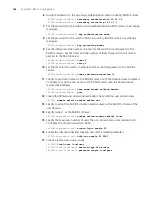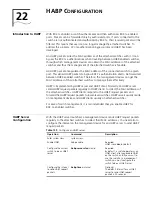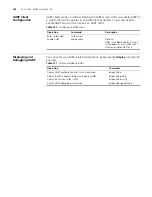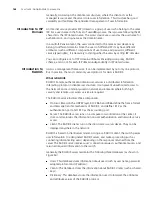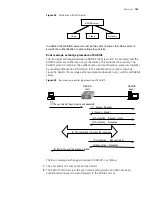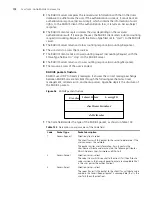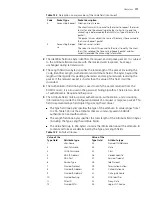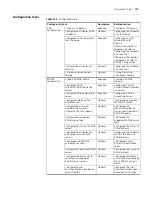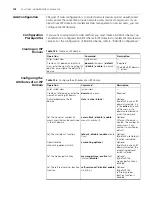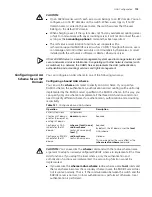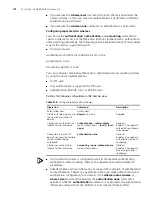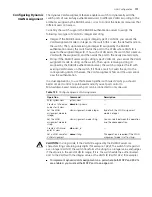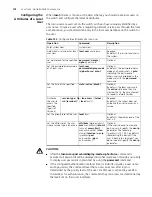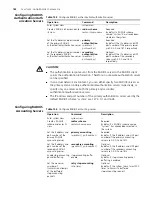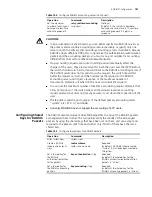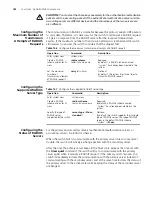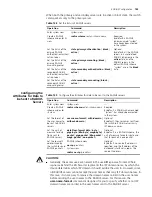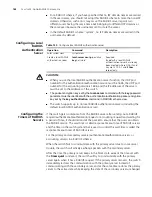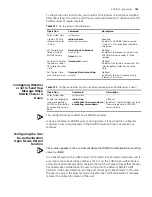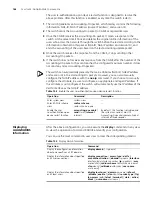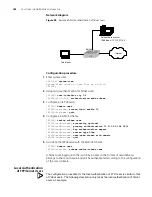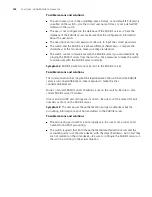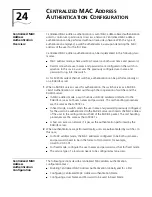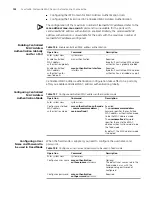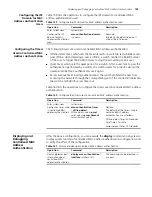
178
C
HAPTER
23: AAA&RADIUS C
ONFIGURATION
Configuring the
Attributes of a Local
User
When
local
scheme is chosen as the AAA scheme, you should create local users on
the switch and configure the relevant attributes.
The local users are users set on the switch, with each user uniquely identified by a
user name. To make a user who is requesting network service pass through the local
authentication, you should add an entry in the local user database on the switch for
the user.
CAUTION:
■
After the
local-user password-display-mode cipher-force
command is
executed, all passwords will be displayed in cipher mode even through you specify
to display user passwords in plain text by using the
password
command.
■
If the configured authentication method (local or RADIUS) requires a user name
and a password, the command level that a user can access after login is
determined by the priority level of the user. For SSH users, when they use RSA
shared keys for authentication, the commands they can access are determined by
the levels set on their user interfaces.
Table 140
Configure the attributes of a local user
Operation
Command
Description
Enter system view
system-view
—
Add a local user and enter local
user view
local-user
user-name
Required
By default, there is no local user in
the system.
Set a password for the specified
user
password
{
simple
|
cipher }
password
Optional
Set the password display mode
of all local users
local-user
password-display-mode
{
cipher-force
|
auto }
Optional
By default, the password display
mode of all access users is
auto
,
indicating the passwords of
access users are displayed in the
modes set with the
password
command.
Set the state of the specified
user
state
{
active
|
block }
Optional
By default, the local users are in
the
active
state once they are
created, that is, they are allowed
to request network services.
Authorize
the user to
access the
specified
type(s) of
service(s)
service-type
{
ftp
|
lan-access
|
{
telnet
|
ssh
|
terminal }
* [
level
level ]
}
Required
By default, the system does not
authorize the user to access any
service.
Set the priority level of the user
level
level
Optional
By default, the priority level of the
user is 0.
Set the attributes of the user
whose service type is lan-access
attribute
{
ip
ip-address
|
mac
mac-address
|
idle-cut
second
|
access-limit
max-user-number
|
vlan
vlan-id
|
location
{
nas-ip
ip-address
port
port-number
|
port
port-number }
}*
Optional
If the user is bound to a remote
port, you must specify the
nas-ip
parameter (the following
ip-address
is 127.0.0.1 by default,
representing this device). If the
user is bound to a local port, you
do not need to specify the
nas-ip
parameter.
Summary of Contents for 4200G 12-Port
Page 10: ...8 CONTENTS...
Page 14: ...4 ABOUT THIS GUIDE...
Page 46: ...32 CHAPTER 5 LOGGING IN THROUGH WEB BASED NETWORK MANAGEMENT SYSTEM...
Page 48: ...34 CHAPTER 6 LOGGING IN THROUGH NMS...
Page 60: ...46 CHAPTER 9 VLAN CONFIGURATION...
Page 64: ...50 CHAPTER 10 MANAGEMENT VLAN CONFIGURATION...
Page 80: ...66 CHAPTER 13 GVRP CONFIGURATION...
Page 98: ...84 CHAPTER 15 LINK AGGREGATION CONFIGURATION...
Page 112: ...98 CHAPTER 18 MAC ADDRESS TABLE MANAGEMENT...
Page 126: ...112 CHAPTER 19 LOGGING IN THROUGH TELNET...
Page 162: ...148 CHAPTER 20 MSTP CONFIGURATION...
Page 274: ...260 CHAPTER 29 IGMP SNOOPING CONFIGURATION...
Page 276: ...262 CHAPTER 30 ROUTING PORT JOIN TO MULTICAST GROUP CONFIGURATION...
Page 298: ...284 CHAPTER 33 SNMP CONFIGURATION...
Page 304: ...290 CHAPTER 34 RMON CONFIGURATION...
Page 338: ...324 CHAPTER 36 SSH TERMINAL SERVICES...
Page 356: ...342 CHAPTER 38 FTP AND TFTP CONFIGURATION...
Page 365: ...Information Center Configuration Example 351 S4200G terminal logging...
Page 366: ...352 CHAPTER 39 INFORMATION CENTER...
Page 378: ...364 CHAPTER 40 BOOTROM AND HOST SOFTWARE LOADING...
Page 384: ...370 CHAPTER 41 Basic System Configuration and Debugging...
Page 388: ...374 CHAPTER 43 NETWORK CONNECTIVITY TEST...
Page 406: ...392 CHAPTER 45 CONFIGURATION OF NEWLY ADDED CLUSTER FUNCTIONS...

